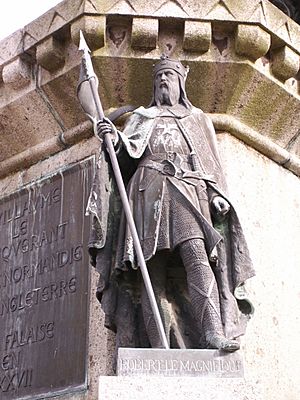Robert I, Duke of Normandy facts for kids

Robert the Magnificent (also known as le Magnifique in French) was the sixth Duke of Normandy. He ruled from 1027 until he passed away in 1035 while returning from a special journey called a pilgrimage. Robert's time as duke was very important for Normandy. He was also the father of William the Conqueror, who later became the King of England in 1066.
Contents
Early Life and Becoming Duke
Robert was born between 1005 and 1010. He was the second son of Richard II, who was the Duke of Normandy, and his mother was Judith of Brittany.
His father, Richard II, had planned for Robert's older brother, Richard III, to become the next duke. Robert was meant to become the Count of Hiémois. In August 1026, their father died, and Richard III became the fifth Duke of Normandy.
However, Robert was not happy with his position. He started a disagreement with his brother and even took control of the city of Falaise. This conflict lasted into early 1027. Eventually, Richard III surrounded Falaise, and Robert had to give up.
A New Duke
Soon after Robert surrendered, Richard III died. There were some people who wondered if Robert had played a part in his brother's death. But Robert was still accepted as the new Duke of Normandy.
Even after Robert became duke, many disagreements between powerful families in Normandy continued. During this time, some less powerful nobles left Normandy to find new opportunities in places like southern Italy.
Robert also had conflicts with important church leaders. He argued with his uncle, Robert II, Archbishop of Rouen, and forced him to leave Normandy for a short time. The Archbishop then put a ban on religious services in Normandy until he was allowed to return and get his lands back. Robert also banished his cousin, Hugo d'Ivry, who was the Bishop of Bayeux.
Normandy's Role in Other Lands
Even with problems at home, Robert got involved in events outside Normandy.
Helping Neighbors
He helped settle a conflict in Flanders between a father and son, Baldwin IV and Baldwin V. Robert promised to support the father, which helped them make peace.
Robert also offered safety to Henry I of France, who was having trouble with his mother, Queen Constance. She wanted her younger son, Robert, to become the next king of France. Because Robert helped Henry I, the king gave him the French Vexin region.
In the early 1030s, Robert also had to deal with his cousin, Alan III, Duke of Brittany, who was trying to expand his territory. Robert led a military effort against Alan III. However, Robert's uncle, Archbishop Robert of Rouen, helped them make peace.
Supporting English Princes
Robert's cousins, Edward and Alfred, were living in Normandy. They were the sons of his aunt Emma of Normandy and Athelred, the King of England. At one point, Robert tried to invade England to help them, but bad weather stopped his ships. The King of England, Cnut the Great, offered to give Edward and Alfred half of England. Robert decided to wait until after his pilgrimage to make a decision about this offer.
The Church and a Special Journey
Robert's feelings towards the Church changed a lot after his uncle, the Archbishop, returned from exile. To make up for his earlier actions, Robert gave back all the Church property he or his followers had taken.
He also decided to go on a pilgrimage to Jerusalem to ask for forgiveness for his past actions. Before he left, he named his young son, William, as his heir, meaning William would rule after him.
Robert traveled through Constantinople and reached Jerusalem. On his way back, he became very ill and died in Nicaea on July 2, 1035. His son William, who was only about eight years old, became the new Duke of Normandy.
Years later, Robert's son William tried to bring his father's body back to Normandy. He got permission, but the people bringing the body heard that William himself had died. So, they decided to bury Robert's body in Italy instead.
Family
Robert had children with his partner, Herleva of Falaise:
- William the Conqueror (born around 1028, died 1087).
- Adelaide of Normandy, who married three times: first to Enguerrand II, Count of Ponthieu, then to Lambert II, Count of Lens, and finally to Odo II of Champagne.
See also
 In Spanish: Roberto I de Normandía para niños
In Spanish: Roberto I de Normandía para niños

